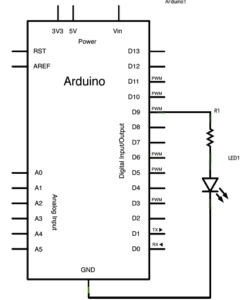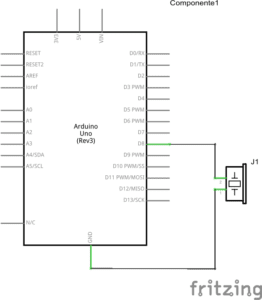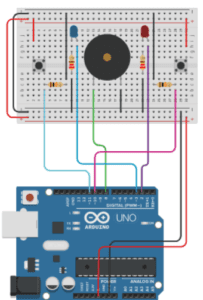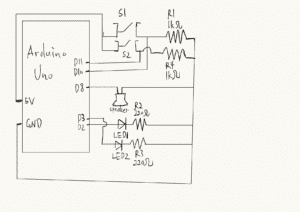Circuit 1: Fade

Components:
1 * Arduino Uno
1 * USB A to B cable
1 * breadboard
1 * LED
1 * 220 ohm resistors
A handful of jumper cables
Videos:
Process:
Generally speaking, the circuit would not be as complicated as those we built in the last recitation because we used Arduino. It only took us 1 or 2 minutes to finish this circuit without encountering any problem and the result is satisfactory. One of the fellows advised us to use a red LED for better effect but I didn’t see much difference…
Circuit 2: toneMelody

Components:
1 * Arduino Uno
1 * USB A to B cable
1 * breadboard
1 * Buzzer
A handful of jumper cables
Videos:
Process:
This is the easiest circuit we have built so far. But there’s one thing to notice that we need to distinguish the positive and negative poles of the speaker. From the second video, you may see that we changed the code to modify the sound it makes (though not a beautiful one). Also, by moving the code from void_setup to void_loop, we made the tune to play continuosly.
Circuit 3: Speed Game

(Original Version)

(My Version)
Components:
1 * Arduino Uno
1 * USB A to B cable
1 * breadboard
1 * buzzer
2 * LEDs
2 * 220 ohm resistors
2 * 10K ohm resistors
2 * pushbuttons/ arcade buttons
A handful of jumper cables
Videos:
Process:
This circuit is a little bit complicated. It involves too many components, especially jumper cables so making a mistake is comparatively easy. To make the whole assembling process more smooth, my teammate and I separated the circuit in half. At first, none of the buttons response to the clicks. After a careful check from one of the fellows, he pointed out that a certain pin was inserted in the wrong line so the whole circuit wasn’t connected. At that time, we were really amazed by the carefulness we ought to have to assemble a circuit like this. However, after we have fixed the problem, only that button could respond to the click and the other one was still not working. This time, we carefully checked every connection but still could not find out the problem. We had no choice but to turn to the fellows again. At his first glance, he pointed out that the push button we were using is not connected to the circuit because the pin was bent. He advised us to use arcade buttons instead and we thought it was an excellent idea. As you can see in the video, after installing the arcade buttons, the whole circuit began to work.
Question 1:
From my perspective, there are just too many occasions that we need to use technologies within our daily lives. The modern digital life is essentially moving your eyes from one screen to another. We have sensors within our phones, our laptops, our hallways, our beloved convenience stores etc. The most frequent way for me to use technology is to look at the cameras for Face ID and unlock my phone. As for the circuits we built, all of them work only when we put codes within Arduino. I feel this is the intriguing part to use technology. The code helps us to unlock endless possibilities with the same materials we use for ordinary circuits. In the article ‘Physical Computing‘, the author expanded the definition of interaction in the narrative of physical computing. He regard input as ‘listen’, processing as ‘thinking’, and output as ‘speaking.’ This analogy somehow makes sense because in our class, we use the same method to carry out interaction with the circuit we build. The input refers to putting code in the arduino and the circuit would respond what we would like to see, which is the ‘output’.
Question 2:
If we put the LEDs at an interval of 1cm, 100,000 LEDs would mean that the total length of the band will be roughly 1,000m. Based on that, I think I would choose a specific stadium and install the LEDs on one of the tracks (one track with two sidelines are approximately 400m x2 = 800m). When an athlete is using the track for training, we can control the LED to form a light band where the light moves exactly a little bit faster than the speed the athlete could run at. In this way, it may help the athlete to improve his or her performance. Even if there are no athletes, a flowing light band at night in a stadium would be a very nice view and could serve as alternative light sources.